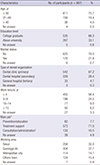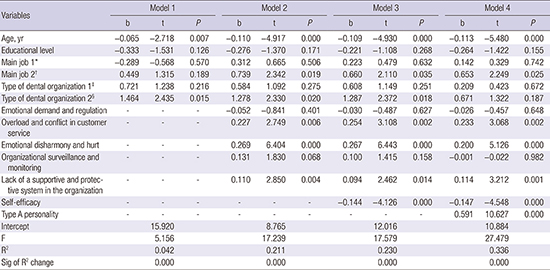1. Central Intelligence Agency (US). The World Factbook 2009. Washington, D.C: Central Intelligence Agency;2009.
2. Hochschild AR. The Managed Heart: Commercialization of Human Feeling. Berkeley, CA: University of California Press;1983.
3. Morris JA, Feldman DC. Managing emotions in the workplace. J Manag Issue. 1997; 9:257–274.
4. Zapf D. Emotion work and psychological well-being: a review of the literature and some conceptual considerations. Hum Resour Manage Rev. 2002; 12:237–268.
5. Maslach C, Schaufeli WB, Leiter MP. Job burnout. Annu Rev Psychol. 2001; 52:397–422.
6. Brotheridge CM, Grandey AA. Emotional labor and burnout: comparing two perspectives of “people work”. J Vocat Behav. 2002; 60:17–39.
7. Grandey AA. When “the show must go on”: surface acting and deep acting as determinants of emotional exhaustion and peer-rated service delivery. Acad Manage J. 2003; 46:86–96.
8. Pugliesi K. The consequences of emotional labor: effects on work stress, job satisfaction, and well-being. Motiv Emot. 1999; 23:125–154.
9. Le Blanc PM, Hox JJ, Schaufeli WB, Taris TW, Peeters MC. Take care! The evaluation of a team-based burnout intervention program for oncology care providers. J Appl Psychol. 2007; 92:213–227.
10. Lee RT, Ashforth BE. A meta-analytic examination of the correlates of the three dimensions of job burnout. J Appl Psychol. 1996; 81:123–133.
11. Bandura A. Self-efficacy: toward a unifying theory of behavioral change. Psychol Rev. 1977; 84:191–215.
12. Brown CG. A systematic review of the relationship between self-efficacy and burnout in teachers. Educ Child Psychol. 2012; 29:47–63.
13. Luszczynska A, Scholz U, Schwarzer R. The general self-efficacy scale: multicultural validation studies. J Psychol. 2005; 139:439–457.
14. Friedman M, Rosenman RH. Type A Behavior and Your Heart. New York, NY: Fawcett Crest;1974.
15. Froggatt KL, Cotton JL. The impact of Type A behavior pattern on role overload-induced stress and performance attributions. J Manage. 1987; 13:87–98.
16. Khan S. Relationship of job burnout and Type A behaviour on psychological health among secretaries. Int J Bus Manage. 2011; 6:31–38.
17. Korean Health & Medical Workers' Union. Current Status and Situations of Emotional Labor in Korean Health Care Providers: Data from a Survey. Seoul: Korean Health Medical Workers' Union;2010.
18. Occupational Safety and Health Research Institute (KR). Developing Korean Emotional labor Scale (K-ELS) and Workplace Violence Scale (K-WVS). Ulsan: Korean Occupational Safety and Health Agency;2014.
19. Chen G, Gully SM, Eden D. Validation of a new general self-efficacy scale. Organ Res Methods. 2001; 4:62–83.
20. Haynes SG, Levine S, Scotch N, Feinleib M, Kannel WB. The relationship of psychosocial factors to coronary heart disease in the Framingham study. I. Methods and risk factors. Am J Epidemiol. 1978; 107:362–383.
21. Maslach C, Jackson SE. The measurement of experienced burnout. J Organ Behav. 1981; 2:99–113.
22. Howard A. A framework for work change. In : Howard A, editor. The Changing Nature of Work. San Francisco, CA: Jossey-Bass;1995. p. 3–44.
23. Bakker AB, Demerouti E, Schaufeli WB. Validation of the Maslach burnout inventory-general survey: an internet study. Anxiety Stress Coping. 2002; 15:245–260.
24. Schaufeli WB. Past performance and future perspectives of burnout research. SA J Ind Psychol. 2003; 29:1–15.
25. Lim SS, Lee W, Hong K, Jeung D, Chang SJ, Yoon JH. Facing complaining customer and suppressed emotion at worksite related to sleep disturbance in Korea. J Korean Med Sci. 2016; 31:1696–1702.
26. Yoon JH, Jeung D, Chang SJ. Does high emotional demand with low job control relate to suicidal ideation among service and sales workers in Korea? J Korean Med Sci. 2016; 31:1042–1048.
27. Yoon JH, Kang MY, Jeung DY, Chang SJ. Suppressing emotion and engaging with complaining customers at work related to experience of depression and anxiety symptoms: a nationwide cross-sectional study. Ind Health. 2017; 55:265–274.
28. Leiter MP. Burn-out as a crisis in self-efficacy: conceptual and practical implications. Work Stress. 1992; 6:107–115.
29. Lee RT, Seo B, Hladkyj S, Lovell BL, Schwartzmann L. Correlates of physician burnout across regions and specialties: a meta-analysis. Hum Resour Health. 2013; 11:48.
30. Alarcon G, Eschleman KJ, Bowling NA. Relationships between personality variables and burnout: a meta-analysis. Work Stress. 2009; 23:244–263.
31. Soria MS, Gumbau RG, Peiro JM. New Technologies and Continuous Training in the Company: a Psychosocial Study. Castelló de la Plana: Publicaciones Universitat Jaume I;2001.
32. Pick D, Leiter MP. Nurses’ perceptions of burnout: a comparison of self-reports and standardized measures. Can J Nurs Res. 1991; 23:33–48.
33. Kirmeyer SL. Coping with competing demands: interruption and the Type A pattern. J Appl Psychol. 1988; 73:621–629.
34. Spector PE, O'Connell BJ. The contribution of personality traits, negative affectivity, locus of control and Type A to the subsequent reports of job stressors and job strains. J Occup Organ Psychol. 1994; 67:1–12.
35. Caplan RD, Jones KW. Effects of work load, role ambiguity, and Type A personality on anxiety, depression, and heart rate. J Appl Psychol. 1975; 60:713–719.
36. Burke RJ, Deszca E. Preferred organizational climates of Type A individuals. J Vocat Behav. 1982; 21:50–59.
37. Burke RJ, Greenglass E. A longitudinal study of psychological burnout in teachers. Hum Relat. 1995; 48:187–202.







 PDF
PDF ePub
ePub Citation
Citation Print
Print





 XML Download
XML Download